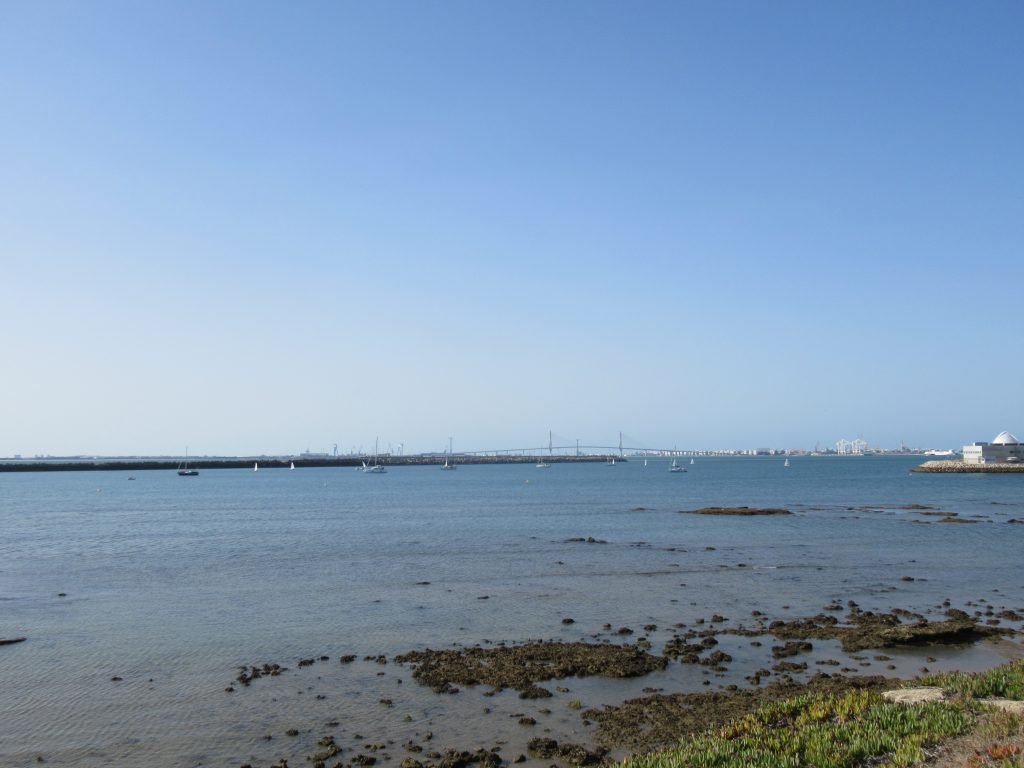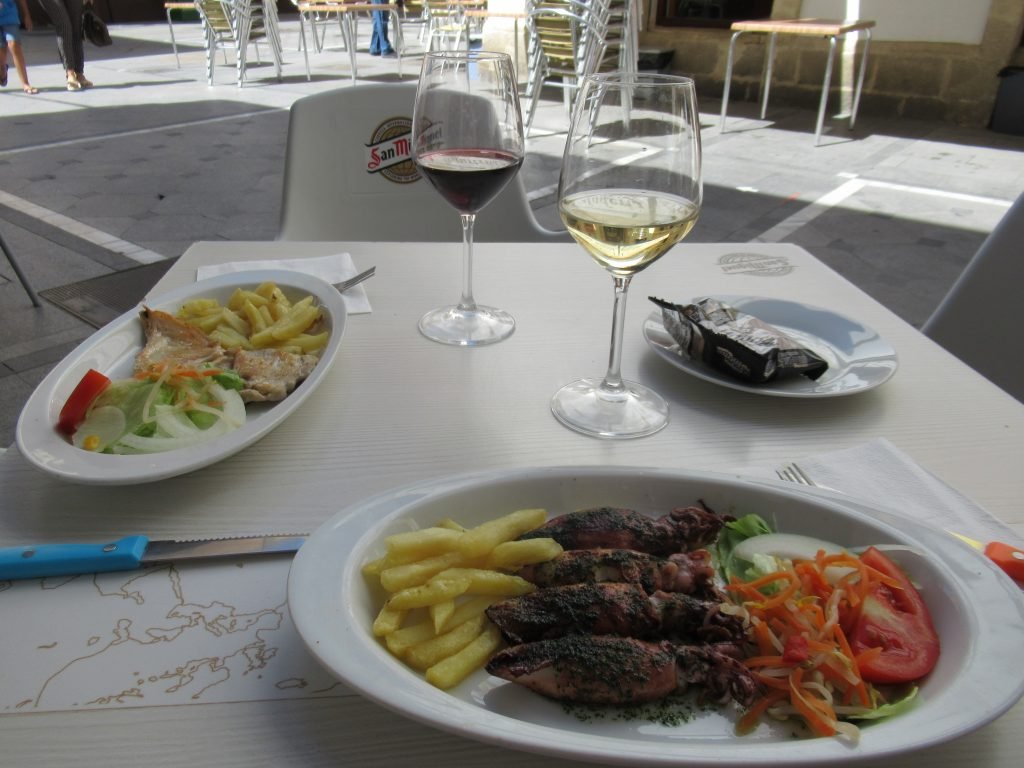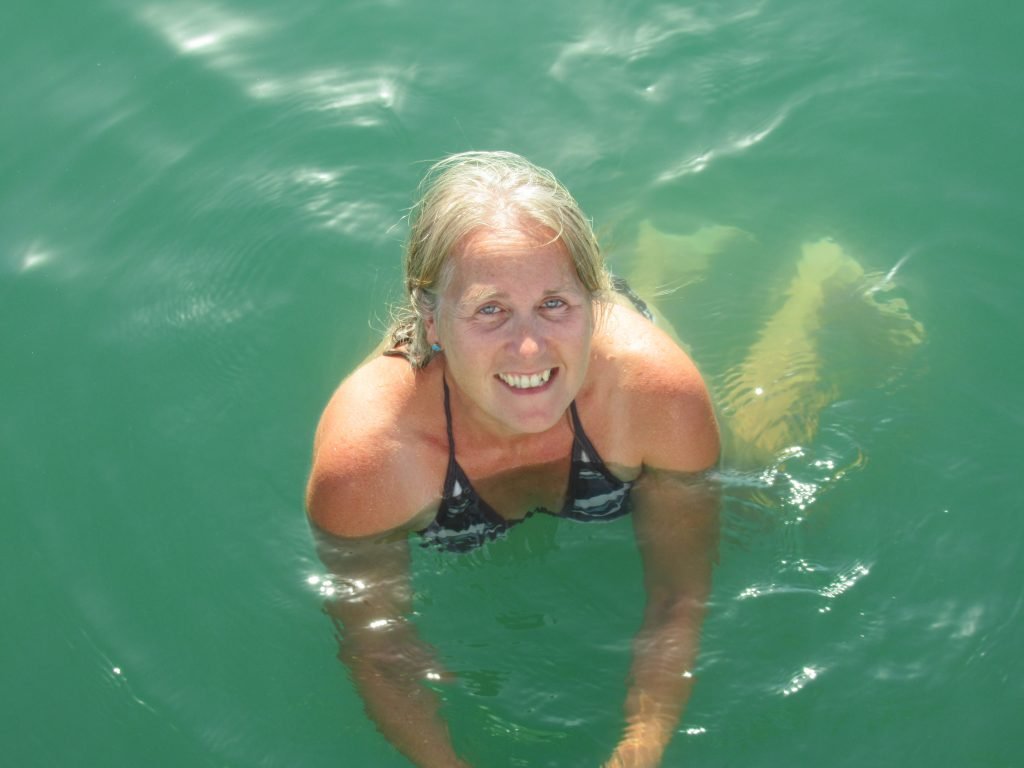We picked up the anchor at 7 am on the 2nd of September to push on the 50nm from Cala Bolonia to Cadiz. We had hoped to split the passage over two days, however, inclement winds were on their way.
As the sun rose, a gentle southerly wind set in allowing us to sail. With the engine silenced, the only noise was from the swishing of Emerald’s bow slicing through the waves. Shearwaters gracefully skimmed the waves. Peace, nature, and sailing = happiness. We made a very respectable 6kts SOG with the tide with us.

Alongside our log entry off of Cabo Trafalgar, Colin wrote “Huzzah”. Alas, a veil of grey shrouded the land so all we could see was the top of the lighthouse. We kept well offshore where conditions were clearer and with less chance of an encounter with a poorly marked fishing pot.
By late morning the fog had burnt off, but we’d lost both the wind and the tide, so on with the engine. Then three hours later a westerly wind provided enough power for us to sail on to the entrance to Cadiz. Large ships were entering and leaving the port city, and with the wind easing, we chose to continue under power to the anchorage.

The Puerto Sherry Anchorage
The anchorage sits between the Rio Guadalete breakwater and Puerto Sherry marina. The available space was larger than expected and headed by a lovely looking expanse of golden sand. Holding was excellent and the breakwater wall provides protection from easterly winds.
We got to thoroughly test the protection as the east wind blew up to 40kts over the next two days. The anchor held firmly and the worst we suffered was a small chop that rippled the sea’s surface. The local sailing and windsurfing school took advantage of the conditions and kept us entertained.
We had a mostly positive experience. One downside was an occasional jetski whizzing about at silly speeds. And music from a beach bar blasted out in the evenings, but thanks to Covid, bars had to close by midnight, so we slept peacefully.

El Puerto de Santa Maria
Two days of boat confinement due to the weather added to the two days of sailing from Gibraltar meant my legs were getting fidgety. The wind had blown itself out, leaving calm in its wake. Time to explore on land! We dinghied the short distance ashore and parked on the end of a small pontoon. It took us a while to escape the sprawling marina complex, and beyond we found a land made of sand. On one side of the road was the beach, and on the other, a huge pine-covered dune. A walk along the beach yielded a small haul of sea glass.
The walk to El Puerto de Santa Maria is almost two miles. We walked along the river estuary, then cut through the streets passing empty warehouses and majestic, but abandoned villas.

Sand to the left of us 
Sand to the right 
Marina artwork
A Town Full of History
The walk to the town of El Puerto de Santa Maria took around 40 minutes. It was a warm day and a building thirst sent us in search of a cafe; we found one under the walls of a castle. Who knew there was a castle here? It was a very pleasant surprise, the first of many. Armed with a map from the tourist office, we set off on a self-guided walking tour. We discovered the town has a long history. The area was settled by Greeks escaping from the Trojan War, according to Homer’s Odyssey. Later came the Phoenicians and Romans, who established a salt industry. The Moors followed in 711, naming the town for the salt, and built a mosque. In 1260, after the Spanish conquest, the mosque became a castle and the town received its current name.
The connection with the sea is strong. Christopher Columbus set sail from here on his first expedition to the Americas. Juan de la Cosa, the cartographer on this voyage, created the first European world map, completed in the town. Merchants settled, made wealthy on the trade that followed these expeditions. The result of this wealth is visible in the grand palaces that make up the old town. There is a large bullring, an ornate church, and numerous convents. Sadly, many of the buildings now look to be in a state of disrepair.






The Fino Trade
The town sits within the Jerez (sherry) triangle with Sanlucar de Barrameda and Jerez. Here, the limestone soil and the local winds provide perfect conditions for grape growing. Fino is the lightest and palest of the sherry varieties and is excellent when drank chilled on a hot day. In the past few centuries, the sherry trade was huge. Evidence of this can be seen in the number of large warehouses in the streets running back from the riverside. Nowadays, most of these buildings are empty, telling the story of sherry’s fall from fashion. However, there are still a small number of houses producing a range of fortified wines; we found one open for tastings and tried a few before buying two plastic jugs to take home.







The next day we returned with hopes to visit the castle, but it was closed for a wedding. And sadly it was closed the next day too, which had been declared a local holiday. Instead, we enjoyed a ridiculously cheap menu del día – a set menu of fish soup, followed by squid and a dessert, washed down with chilled white wine. And all for only €7.

History and Watchtowers in Cadiz
We had one last day to fill before the weather settled for us to continue on. We’d visited Cadiz back in 2014 and had enjoyed wandering its maze of streets, so decided on a return visit via the ferry that ran regularly from Santa Maria to Cadiz. In 2014 we had followed one of the coloured walking routes that showcase aspects of the city’s history. Back then we explored the orange route along the coastal defences. This time we found ourselves following a green line painted on the ground. This took us through the oldest part of the city along narrow cobbled lanes where the remains of Greek, Roman, and Moorish buildings jostled for space.
Perhaps in another life I was a bird, as I love looking down on the ground from above. Given that I don’t have wings, I have to make the most of man made opportunities to get up high. Cadiz has over 126 watchtowers, a symbol of the owners prosperity in the 18th century. Many of the houses were owned by merchants, and each merchant wanted to keep a lookout for his own ships returning to Cadiz.
The Tavira Tower is one of the watchtowers that is open to the public. I climbed the 170 steps, 45m up, to see the glorious bird’s eye view of the city.

Cathedral 
City walls 
A Theatre Cafe on Silence Street? 
The market 
Open spaces

A tower with a view of other towers 
The cathedral and sea







Don’t forget to look up! Cadiz has some fantastic architecture – narrow streets, a “death by beheading”, tiles, and decorative balcony supports.



The street level view is impressive too. There are many magnificent doorways or entrances to be spotted.
Onwards to Glue River
Before we left, I had my last swim of the season. I can confirm that Atlantic water is definitely colder than Mediterranean waters.
Our next passage required accurate timing so as to cross a river bar with enough water under us and on a rising tide. It meant an early start, but the desire was strong. We were at last returning to the Rio Guadiana, known affectionately as Glue River for its hold on people and boats.

Sailing Info
2nd September: Cala Bolonia to Puerto Sherry – 49nm (22nm sailed)
Anchored in mud/sand, 6m at high water, in position 36 34.744’N 6 14.739’W
The Social Media Bit: Want to Follow Us?
If you’d like to follow us on other social media platforms (Facebook, Instagram and YouTube), you can do so by using these links:
Or use the link below to track our voyage on NoForeignLand.com.
And finally, you can sign up to receive email notifications of new blogs using the subscribe box at the bottom of this page.
Thank you from Nichola & Colin













Dear Nicola and Colin, we too remember Puerto de Santa Maria fondly – we visited it some ten years ago when we spent a wild long weekend in Cadiz celebrating the Spanish Carnival (Cadiz being to Spain what Brighton is to the UK, famous since antiquity for its Dancing Girls …). Luckily we got to enjoy a guided tour of the tiny castle with its well-preserved mosque and adjacent Sherry bodega.
On another occasion I took my then teenage son on a week long hire car trip across Andalucia where a particular highlight (at least for me) was a visit to the excavated remains of the Roman town of Colonia Bolonia or Baelo Claudia – famous throughout the ancient world for its main export product of Garum (fermented fish sauce)! We enjoy following your journeys and might perhaps even meet up at some point down the line once we have taken over the catamaran we plan to commission next summer … planned departure from Hampshire will be Summer of 2022.
Hi Kai, we know Brighton well, the marina was home for the first six years of owning Emerald, so it’s a shame we won’t be able to visit the carnival in Cadiz, as I’m guessing they will all be cancelled for next year. We may still be around this area in 2022, we need to do some boatyard work so timings are all dependant on how well the jobs go So hopefully we’ll get to meet up sometime